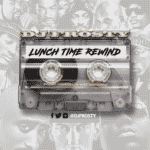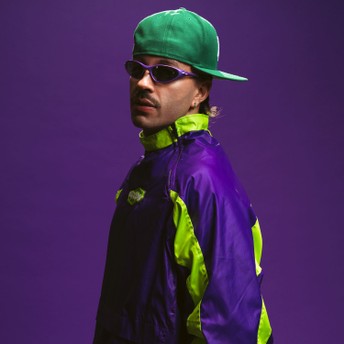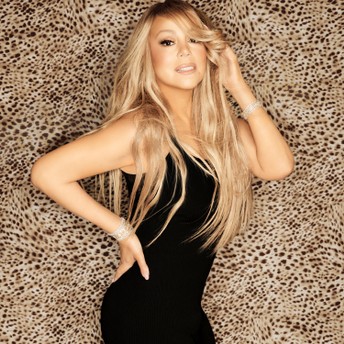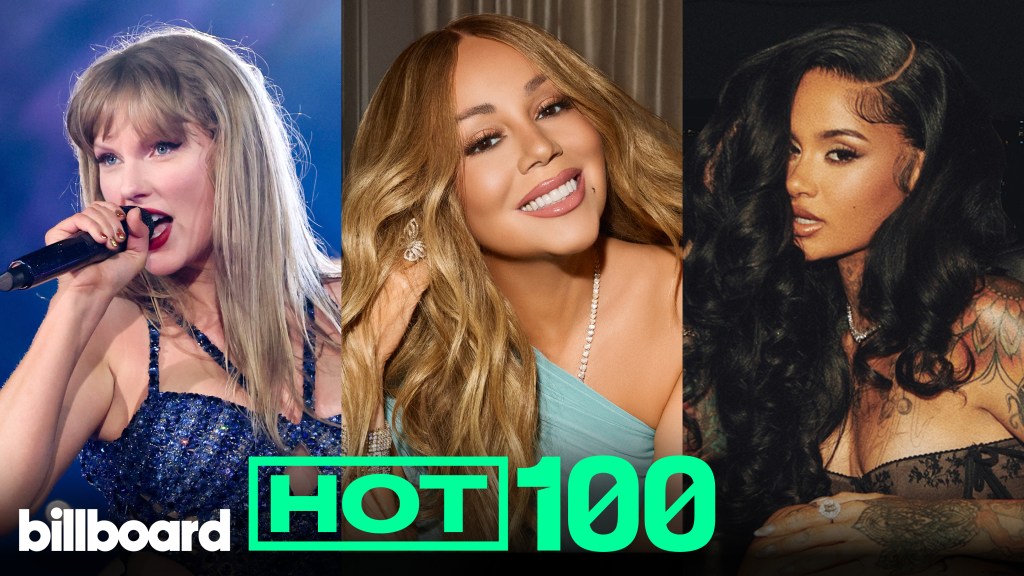Chart Beat
Page: 4
Trending on Billboard
Karol G and Feid‘s “Verano Rosa” marks the pair’s first collaborative No. 1 as the song soars to the top of Billboard’s Latin Airplay chart (dated Nov. 29). It becomes the third track from Karol’s album Tropicoqueta to claim the top spot. This achievement also earns Karol G her 20th chart-topper and Feid his 11th.
Explore
See latest videos, charts and news
“Verano Rosa” flies 9-1 on the overall Latin radio ranking with a 55% boost in audience impressions, to 8.9 million, earned in the United States during the tracking week ending Nov. 20th, as reported by Luminate. The track also takes the Greatest Gainer honor, awarded to the song with the largest audience growth of the week.
While multiple two-way collaborations have topped the Latin Airplay chart in 2025, “Verano Rosa” stands out as only the second female-male pairing to achieve the feat. Earlier in the year, Silvestre Dangond and Emilia claimed the No. 1 spot with their hit “Vestido Rojo” (which coincidentally shares the same initials as Karol and Feid’s track, VR) leading the chart for one week in June.
Karol and Feid’s previous collab, “Friki” took them to a No. 36 high on Latin Airplay in 2022. Meanwhile, “+57,” where the pair also teamed up with DFZM, featuring Ovy on The Drums, J Balvin, Maluma, Ryan Castro and Blessd, gave each a top 10 on the multi-metric Hot Latin Songs chart, reaching No. 4 high in 2024.
“Verano Rosa” becomes Karol’s 20th No. 1 on Latin Airplay and the third ruler from her No. 1 album Tropicoqueta. The album’s lead single, “Si Antes Te Hubiera Conocido,” shattered records earlier this year, surpassing Shakira’s “La Tortura,” featuring Alejandro Sanz, with an unmatched 26-week run at the summit of the 31-year-old chart. Second single, “Latin Foreva,” also reached No. 1, on the July 26-dated chart.
For Feid, “Verano” marks his 11th ruler. Prior to the new hit, the Colombian topped the chart for one in April through “Háblame Claro,” with Yandel.
Grupo Cañaveral & Marisela Celebrate First Regional Mexican Airplay No. 1:
Grupo Cañaveral de Humberto Pabón and Marisela claim their first No. 1 on the Regional Mexican Airplay chart, as “Que Bello” climbs to the top after a 4-1 surge with 8 million audience impressions, up 46%, during the tracking period.
The breakthrough marks Grupo Cañaveral’s first No. 1 on Regional Mexican Airplay after debuting on the chart in 2020. It comes after three prior entries, with two songs peaking at No. 18 as their highest achievement before now.
For Mexican American singer Marisela, “Qué Bello” is a successful return. It’s her first entry on any Billboard chart in over six years, and her first No. 1 on any Billboard chart since her four-week reign with 20 Éxitos Mortales on the Top Latin Pop Albums chart in 2009.
Trending on Billboard Billboard published the October Boxscore report on Tuesday (Nov. 25), with Chris Brown repeating as the biggest touring act of the month. But while the biggest stars of rock, hip-hop and more packed stadiums, comedians were road warrioring their way to sold-out theaters and arenas. Here, we’re looking at the five biggest […]
Chris Brown’s Breezy Bowl XX wrapped over a month ago, but is still generating new chart highlights. According to figures reported to Billboard Boxscore, its seven shows in October grossed $46.8 million and sold 286,000 tickets, scoring yet another month at No. 1 on Billboard’s Top Tours chart.
When Brown was No. 1 last month, he matched a Boxscore feat only previously achieved by Bad Bunny and Beyonce by linking two consecutive months with a reported gross of $90 million or more. Now, he joins them in another elite club, as the only acts to ever string together three consecutive months at No. 1 on Top Tours.
Related
In fact, Brown immediately follows Beyonce’s three-peat from May-July, capping a six-month stretch of only those two superstars atop the list. The streak ends here, as he had no concerts on the books for November.
Brown’s October routing mostly stuck to the American Southeast, selling out stadiums in Atlanta; Birmingham, Ala.; New Orleans; and Raleigh, N.C.. But his stop in Washington, D.C. was the biggest, playing to 121,000 fans over three nights (Oct. 5, 8-9), combining for $20.7 million.
Those shows at Nationals Park give Brown his first month at No. 1 on Top Boxscores. He’s the first artist in venue history to report an engagement with a gross of more than $10 million (let alone $20 million), attendance of more than 100,000, or a string of three shows.
Since launching in June, Breezy Bowl XX grossed $295.5 million and sold just under two million tickets (1.983 million) over its 49 shows in Europe and North America. It’s the highest-grossing and best-selling tour of Brown’s career, more than three times over.
Guns N’ Roses follows at No. 2 on Top Tours, with $35.2 million and 346,000 tickets from 11 shows in October. It’s the second highest gross of the month, but the hard rock legends sold more tickets than anyone else.
GNR stakes their claim with the Latin American leg of the Because What You Want & What You Get Are Two Completely Different Things Tour. The biggest one-night stop was the Oct. 25 performance at Sao Paulo’s Allianz Parque ($5.2 million; 47,600 tickets), but Buenos Aires in Argentina was the band’s ultimate winner, with $7.8 million and 73,300 tickets over two nights (Oct. 17-18) at Estadio Tomas Adolfo Duco.
The tour began on May 1 in South Korea, playing throughout Asia and Europe over the summer. Those 27 shows grossed $95.6 million and sold 823,000 tickets. The October and November shows push the tour’s total revenue well over the $100 million mark, with one show in Mexico City left to be reported.
Yesterday (Nov. 24), Guns N’ Roses announced its 2026 world tour with headline dates in Brazil, Europe, and North America. It will continue a consistent pattern of touring for the band since reuniting in 2016. Since then, it has grossed more than $980 million, surely surging beyond $1 billion with next year’s tour.
Brown and GNR’s totals are significantly down from top honors in September, marking the end of stadium season in North America and Europe. Still, the top 30 is strong, with a total gross of $568.7 million and attendance of 4.5 million. Those figures are up 7% and 6%, respectively, from October of last year.
Two rap acts follow in the top five, with Travis Scott and YoungBoy Never Broke Again at Nos. 3-4, respectively. It’s relatively rare for a rapper to be in the top five, but the one-two punch of Scott and YoungBoy lengthens a strong 2025 for the genre, marking the third month where two such artists (with significant history on the Top Rap Albums and Hot Rap Songs charts) have paired up simultaneously. Tyler, The Creator did it in February with Drake, and again in March with j-hope.
They took wildly different paths to the top five this month. YoungBoy played 18 arena shows in the U.S., stacking up to $32.8 million in the second month of his first headline tour. Scott played five stadiums in Asia and South Africa, pushing his sprawling Circus Maximus Tour to $265 million since launching in 2023.
Lady Gaga rounds out the top five with $31.9 million and 185,000 tickets sold while in Europe on The Mayhem Ball. It’s her fourth month in the top 10 this year, stretching back to May when she hit Singapore’s Indoor Stadium for four nights. Through her Paris shows (Nov. 17-18, 20, 22), Gaga has grossed more than $225 million and sold 1.1 million tickets in 2025.
Last month, Tate McRae and Benson Boone made their top 10 debuts on the monthly Top Tours listing. This month, McRae ranks even higher (at No. 6) as her $111 million Miss Possessive Tour came to a close. She passes the proverbial baton, as another young woman in pop hits the top 10 for the first time: Laufey is No. 10 with $19.2 million and 180,000 tickets sold.
Trending on Billboard Taylor Swift’s “The Fate of Ophelia” rises a spot to No. 1 on Billboard’s Adult Pop Airplay chart dated Nov. 29. The song becomes her 14th leader on the list, the most among soloists. Overall, only Maroon 5 has more, with 15. The track became the highest debuting hit in the chart’s […]
Trending on Billboard Tasha Cobbs Leonard and John Legend move 3-1 on Billboard’s Gospel Airplay chart dated Nov. 29 with their collaboration “Church,” marking a significant week for both artists. Cobbs Leonard adds to an impressive streak at the top of the format, notching her 10th leader, while Legend earns his first appearance — and […]
Trending on Billboard
SiriusXM is serving up the soundtrack to this year with the Billboard 2025 #1s Channel.
Listeners can relive 2025’s biggest chart-topping songs, according to Billboard’s weekly rankings, spotlighting pop, country, R&B/hip-hop, rock and alternative, Latin and more. Plus, flashbacks will highlight No. 1 favorites from throughout the 2020s.
The channel premiered Tuesday (Nov. 25) and is available exclusively on the SiriusXM app (channel 502) through Dec. 8.
Explore
See latest videos, charts and news
The Billboard 2025 #1s Channel features a range of music that defined this year and beyond, including Sabrina Carpenter’s “Manchild,” Lady Gaga and Bruno Mars’ “Die With a Smile,” HUNTR/X’s “Golden,” Kendrick Lamar and SZA’s “Luther,” Taylor Swift’s “The Fate of Ophelia,” Morgan Wallen’s “What I Want,” featuring Tate McRae, and Alex Warren’s “Ordinary.”
The Billboard 2025 #1s Channel marks the latest partnership between SiriusXM and Billboard — and accompanies the recently premiered Billboard Holiday Countdown, which is dashing through the 100 biggest seasonal favorites according to historical performance on Billboard’s Holiday 100 chart. The festive feature is available for streaming on-demand on the SiriusXM app through Dec. 26.
Previous SiriusXM and Billboard collaborations include the Billboard Latin Music Week Channel, the Billboard Top 500 R&B Countdown, the Billboard Top 500 Summer Hits Countdown, the Billboard Women of Pop Countdown and the Billboard #2 Countdown Channel. Additionally, SiriusXM’s Big 40 Countdown, on 80s on 8, and the Back in the Day Replay, on ‘90s on 9, are based on historical weekly Billboard Hot 100 charts, with other surveys counted down on 70s on 7 and Prime Country.
Trending on Billboard
As with all Billboard lists, we’ve made the Holiday 100 and checked it twice, as the ranking returns to Billboard’s charts menu. The survey ranks the top seasonal songs of all eras via the same formula used for the Billboard Hot 100, blending streaming, airplay and sales data.
Explore
See latest videos, charts and news
Mariah Carey‘s “All I Want for Christmas Is You” – which rises three spots to No. 8 on the Hot 100 – rules the Holiday 100 dated Nov. 29 for a 66th week of the chart’s 74 total weeks since the tally originated in 2011.
The only other Holiday 100 No. 1s to date: Justin Bieber’s “Mistletoe,” for a week in the 2011 holiday season; Pentatonix’s “Little Drummer Boy” (one, 2013) and “Mary, Did You Know?” (two, 2014); Ariana Grande’s “Santa Tell Me” (one, 2014); and Brenda Lee’s “Rockin’ Around the Christmas Tree” – which reigned for three weeks on both the Holiday 100 and Hot 100 in 2023, granting the legendary singer a gift 65 years in the making, following the song’s 1958 release.
Carey’s carol is up on the Holiday 100’s housetop with 15.7 million streams (up 14% week-over-week), 9.7 million airplay audience impressions (up 82%) and 1,000 sold (up 13%) in the United States Nov. 14-20, according to Luminate.
The song also boasts top honors on Billboard’s Greatest of All Time Holiday 100 Songs chart.
“When I wrote [it], I had absolutely no idea the impact the song would eventually have worldwide,” Carey marveled of “All I Want for Christmas Is You” in 2021. “I’m so full of gratitude that so many people enjoy it with me every year.”
Rounding out the Holiday 100’s top five are Wham!’s 1984 anthem “Last Christmas” — at a new No. 2 high; Lee’s “Rockin’ Around the Christmas Tree” (No. 3); Bobby Helms’ “Jingle Bell Rock,” from 1957 (No. 4); and Grande’s “Santa Tell Me” (No. 5).
Meanwhile, three songs reach the Holiday 100 for the first time: Gwen Stefani’s new Amazon Music original, “Shake the Snow Globe” (No. 76); Skillet’s “O Come, O Come Emmanuel,” also new this year (No. 79); and Lindsey Stirling’s “Carol of the Bells,” from 2017 (No. 82).
The entire latest Holiday 100, and all other seasonal charts — Top Holiday Albums, Holiday Streaming Songs, Holiday Airplay, Holiday Digital Song Sales, Holiday 100 Songwriters and Holiday 100 Producers — along with all additional rankings, will update on Billboard.com tomorrow, Nov. 25.

Trending on Billboard
HUNTR/X’s “Golden,” from Netflix’s record-breaking animated movie KPop Demon Hunters, tops the Billboard Global 200 and Billboard Global Excl. U.S. charts for a 17th week each. The song became the first No. 1 on each list for the act, whose music is voiced by EJAE, Audrey Nuna and REI AMI, in July.
Explore
See latest videos, charts and news
Meanwhile, Mariah Carey’s “All I Want for Christmas Is You” merrily makes its way back to the Global 200’s top 10 (18-6); RAYE adds her second top 10 on the chart with “Where Is My Husband!” (13-7), which also becomes her third top 10 on Global Excl. U.S. (13-5); and Olivia Dean notches her second Global 200 top 10 with “So Easy (To Fall in Love)” (14-8).
The Billboard Global 200 and Global Excl. U.S. charts rank songs based on streaming and sales activity culled from more than 200 territories around the world, as compiled by Luminate. The Global 200 is inclusive of worldwide data and the Global Excl. U.S. chart comprises data from territories excluding the United States.
Chart ranks are based on a weighted formula incorporating official-only streams on both subscription and ad-supported tiers of audio and video music services, as well as download sales, the latter of which reflect purchases from full-service digital music retailers from around the world, with sales from direct-to-consumer (D2C) sites excluded from the charts’ calculations.
“Golden” tops the Global 200 with 102.3 million streams (down 7% week-over-week) and 10,000 sold (down 14%) worldwide in the week ending Nov. 20.
The song has the third-longest command since the Global 200 began in September 2020. “All I Want for Christmas Is You” has ruled for 19 weeks since that December and Lady Gaga and Bruno Mars’ “Die With a Smile” dominated for 18 weeks starting in September 2024.
Taylor Swift’s “The Fate of Ophelia” holds at No. 2 on the Global 200, after two weeks at No. 1 in October; Dean’s “Man I Need” rises a spot to a new No. 3 best; Alex Warren’s “Ordinary” falls 3-4, following 10 weeks on top beginning in May; and Swift’s “Opalite” keeps at No. 5, after hitting No. 2.
“All I Want for Christmas Is You” sleigh-rides 18-6 on the Global 200 with 39.4 million streams (up 28%) and 3,000 sold (up 23%) worldwide.
“Where Is My Husband!” jumps 13-7 on the Global 200, led by 35.1 million streams (up 14%) globally. RAYE earns her second top 10 on the chart, after “Escapism,” featuring 070 Shake, hit No. 7 in January 2023.
Plus, “So Easy (To Fall in Love)” flies 14-8 on the Global 200 (36.1 million streams, up 15%, worldwide). Dean, thus, charts both of her career top 10s on the ranking simultaneously.
“Golden” leads Global Excl. U.S. with 80.1 million streams (down 6%) and 6,000 sold (down 8%) beyond the U.S.
“Golden” ties for the second-longest No. 1 run on Global Excl. U.S., tying “Die With a Smile.” The songs trail only ROSÉ and Bruno Mars’ “APT.,” which led for 19 weeks in 2024 into this year.
“The Fate of Ophelia” repeats at No. 2 on Global Excl. U.S. after two weeks on top in October; “Man I Need” lifts 4-3 for a new high; and “Ordinary” slides 3-4 after eight weeks at No. 1 starting in May.
“Where Is My Husband!” bounds 13-5 on Global Excl. U.S. (28.3 million streams, up 14% outside the U.S.) It’s RAYE’s third top 10 on the chart, after “Escapism” (No. 6, January 2023) and “Prada,” with casso and D-Block Europe (No. 8, October 2023).
The Billboard Global 200 and Billboard Global Excl. U.S. charts (dated Nov. 29, 2025) will update on Billboard.com tomorrow, Nov. 25. For both charts, the top 100 titles are available to all readers on Billboard.com, while the complete 200-title rankings are visible on Billboard Pro, Billboard’s subscription-based service. For all chart news, you can follow @billboard and @billboardcharts on both X, formerly known as Twitter, and Instagram.
Luminate, the independent data provider to the Billboard charts, completes a thorough review of all data submissions used in compiling the weekly chart rankings. Luminate reviews and authenticates data. In partnership with Billboard, data deemed suspicious or unverifiable is removed, using established criteria, before final chart calculations are made and published.
Trending on Billboard Mariah Carey’s “All I Want For Christmas Is You” has officially made its way back into the top 10 of the Hot 100, while “Folded,” “Mutt” and more slip a spot. Can the queen of the holiday season take No. 1 this week? Tetris Kelly: It’s time! This is the Billboard Hot […]

Taylor Swift’s “The Fate of Ophelia” rules the Billboard Hot 100 for a seventh week, having led in each of its weeks on the chart so far.
Of Swift’s 13 career Hot 100 No. 1s, “The Fate of Ophelia” is her third to have ruled for at least seven weeks. It trails only “Anti-Hero” (eight, beginning Nov. 5, 2022) and ties “Blank Space” (seven, Nov. 29, 2014).
Meanwhile, “The Fate of Ophelia” is the first song to spend its first seven weeks on the Hot 100 at No. 1 since BTS’ “Butter” in June-July 2021. No song has led the chart longer consecutively from its debut since Olivia Rodrigo’s “Drivers License” was No. 1 in its first eight weeks in January-March 2021.
Elsewhere in the Hot 100’s top 10, Mariah Carey’s “All I Want for Christmas Is You” returns to the region, making a three-place festive flight to No. 8. The modern classic, from 1994, has led for 18 total weeks dating to its first in 2019.
Check out the full rundown of this week’s Hot 100 top 10 below.
The Hot 100 blends all-genre U.S. streaming (official audio and official video), radio airplay and sales data, the lattermost metric reflecting purchases of physical singles and digital tracks from full-service digital music retailers; digital singles sales from direct-to-consumer (D2C) sites are excluded from chart calculations. All charts (dated Nov. 29, 2025) will update on Billboard.com tomorrow, Nov. 25. For all chart news, you can follow @billboard and @billboardcharts on both X, formerly known as Twitter, and Instagram. Plus, for all chart rules and explanations, click here.
Luminate, the independent data provider to the Billboard charts, completes a thorough review of all data submissions used in compiling the weekly chart rankings. Luminate reviews and authenticates data. In partnership with Billboard, data deemed suspicious or unverifiable is removed, using established criteria, before final chart calculations are made and published.
‘Ophelia’ Streams, Airplay & Sales

 State Champ Radio
State Champ Radio 




